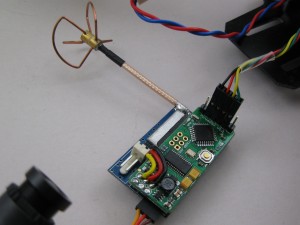 Buying Antennas – the first mistake
Buying Antennas – the first mistake
I got a couple of these TS350 10mW 5.8GHz FPV transmitters from Hobbyking and a set of these circular polarized antennas with SMA connectors (pin centre). These were the wrong antenna connectors, I should have got the RP-SMA (hole in centre) type; these.
Because I go the wrong ones I cut the plugs off, fitted a new plug to the receive antenna (4-lobe) and soldered the transmit antenna (3-lobes) directly to the transmitter.
This picture shows the transmitter with a minimOSD attached and the antenna soldered directly to the transmitter. The SMA connector was removed from the transmitter.
Testing – the second mistake
To test I attached the camera, transmitter (with OSD) and 3-cell LiPo battery to the top of a 1.5M wooden garden stake and went off to the local river.
The first tests didn’t go very well at all. Range was much less than I was expecting. Beyond about 50 meters the video was noisy and there was interference that looked like wifi noise.
Thinking about it later I realized that I was using my standard ground-station receivers and antennas, which are right-hand polarized. The new antennas are left-hand polarized. Still an interesting test of what happens when you mix polarizations; not a good idea.:) Unfortunately, I don’t have a right-hand polarized helical receive antenna.
Another trip out, this time using the matching receive RH-CP skew-planar (4 lobe) antenna gave much better results.
The picture was clear and usable out to about 400 meters and visible but quite noisy out to 700 meters. With no sign of the wifi type interference. Using the LH-CP helical the picture was detectable out to 1KM but only with ideal alignment, very noisy and there was a lot of wifi type interference.
Initial Conclusion
This suggests that with matching polarizations (both RH-CP) , using a helical receive antenna, the 10mW FPV transmitter should work out past 700M, and probably to 1KM or a bit more.
Miss-matched polarization reduces range, and you see a lot more interference, even at closer ranges.
Modified to suit the NZ ISM band
This transmitter has been modified to operate only on channels that fall within the local ISM 5.8GHz band. The modification procedure is almost identical to that shown here.
Next step
I’ve got this transmitter/OSD setup on a new quad. When the weather improves or at the next indoor flying, we’ll see if it works.